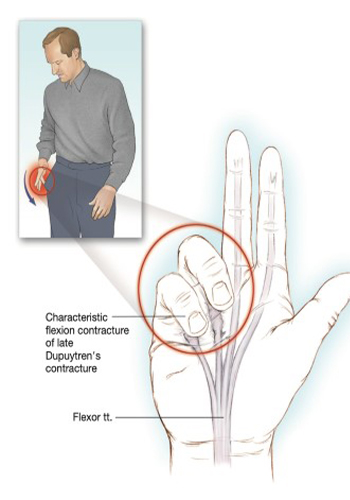Prof. Dr. Serbülent Gökhan Beyaz

Dupuytren’s Contracture
Dupuytren’s Contracture
Clinical Syndrome
Dupuytren’s contracture is a common problem. Although initially painful, the pain decreases as the condition progresses. As a result, patients suffering from Dupuytren’s contracture are often more functional than pain they seek medical help for disability. Dupuytren’s contracture is caused by progressive fibrosis of the palmar fascia. Initially, the patient may notice fibrotic nodules along the flexor tendons of the hand, which are sensitive to palpation. As the disease progresses, these nodules merge and form fibrous bands around the flexor tendons, which gradually thicken and contract, which has the effect of pulling the affected fingers into flexion. Any finger The ring and little fingers are most often affected, although Dupuytren’s contracture can develop. If left untreated, permanent flexion contractures of the fingers may develop. The plantar fascia can be affected at the same time. Dupuytren’s contracture it is considered to have a genetic basis and is most often observed in male patients of north Scandinavian origin. The disease can also be associated with palm trauma, diabetes, alcoholism, and long-term use of barbiturates. Disease it rarely occurs before the fourth decade.
Signs and Symptoms
In the early stages of the disease, hard fibrotic nodules can be palpated along the path of the flexor tendons. These nodules are usually called calluses or warts it is misdiagnosed. At this early stage, pain is always present. As the disease progresses, stretched fibrous bands are formed; they can cross the metacarpophalangeal joint and, as a result, the proximal interphalangeal joint. Palpation of these bands although they are not painful for and limit finger extension, finger flexion remains relatively normal. At this point, patients often seek medical help due to the difficulty of wearing gloves and reaching into their pockets. In the last stages of the disease, flexion contracture develops with its negative impact on function. Arthritis can be accompanied by gout of the metacarpal and interphalangeal joints and Dupuytren’s contracture of the trigger finger, and the patient’s it can aggravate his pain and disability. Treatment
The initial treatment of pain and functional disability associated with Dupuytren’s contracture includes nonsteroidal anti-inflammatory drugs (NSAIDs) or cyclooxygenase-2 inhibitors and a combination of physical therapy. To protect the fingers, a night splint can help. If further symptomatic relief is required, the following injection technique is a reasonable next step. Physical exercises that include local heat and light range of motion exercises the methods should be applied to the patient for several days after the injection is made. Severe exercise should be avoided, as this will aggravate the patient’s symptoms.
